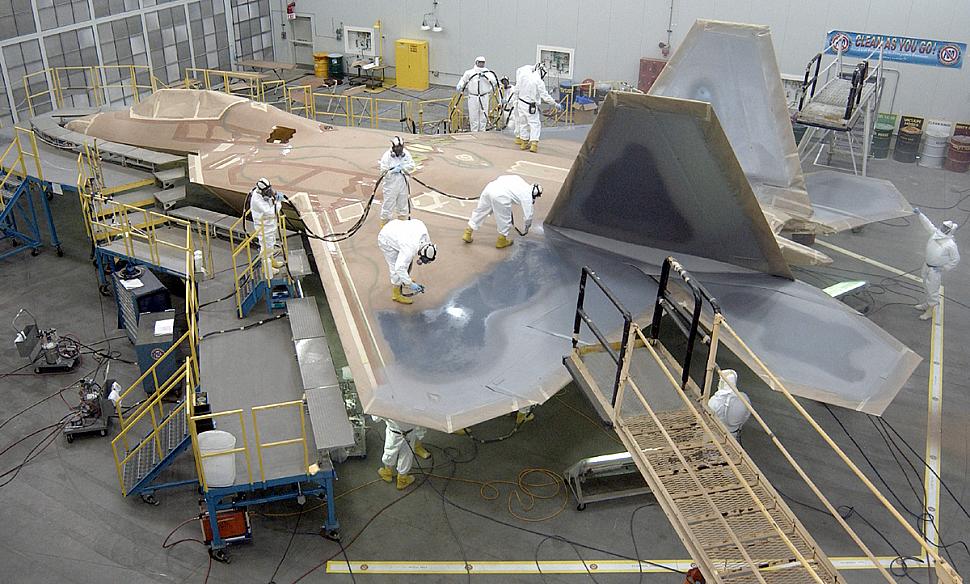Fighter Jet News
F-22 Raptor News
New horizontal stabilator design and manufacturing process for the F-22 program
June 26, 2002 (by
Jeff Hollenbeck) -
Lockheed Martin has developed a new horizontal stabilator design for the F-22 Raptor that will save the program $1 million per aircraft shipset of two.

Stabilators are the large, left- and right-hand wing-like aerodynamic control structures horizontally mounted to the F-22's tail. They work either together or independently to control the Raptor's up-and-down (pitch), spin, roll, and yaw movements. Unlike stabilizers, which have both a fixed and a moving surface, the entire horizontal stabilator moves as a single unit to reposition the aircraft in the air.
"The development and implementation of the stabilator's new design and manufacturing process is part of the F-22 program's ongoing product improvement initiative," said Bob Rearden, Lockheed Martin Aeronautics Co. vice president and F-22 program general manager. "The savings incurred through this initiative will help contain the F-22's cost, and ensure that we can build all the Raptor's the U.S. Air Force needs at a price our country can afford." Currently, the U.S. Air Force has an F-22 acquisition goal of 339 aircraft.
Lockheed Martin's new stabilator design involves mechanically fastening composite materials around a central shaft rather than bonding the materials under high pressure and heat in an autoclave. The new design also incorporates removable edges, which will make the stabilators easier to maintain or repair in the field. The manufacturing process associated with the new design will shave approximately 30 pounds of weight from each stabilator and reduce its build time by approximately 25 percent.
Lockheed Martin Aeronautics Co. has competitively selected Vought Aircraft Industries of Dallas, Texas, to build the new stabilator. Under the terms of this initial $40 million contract, Vought will begin manufacturing the new stabilators early next year and produce 85 shipsets through 2007. Raptor 4040, the fortieth aircraft off the assembly line, will be the last F-22 equipped with the original stabilators. The first F-22 equipped with Vought-built stabilators will be Raptor 4041, the first aircraft to be built in production Lot 3. This aircraft, which will be the first fully combat-ready F-22, is slated for delivery to Langley Air Force Base, Va.
Approximately 20 workers currently build the stabilators at Lockheed Martin's Marietta, Ga., facility. After this work transfers to Vought next year, the Marietta employees will be given the opportunity to retrain as aircraft coaters or finishers, a job area where Lockheed Martin is currently understaffed and actively recruiting.

Employees at the Lockheed Martin Aeronautics Company assembly plant at Marietta, Georgia, paint the first operational F-22 Raptor #01-4018 to be delivered to the Air Force. The jet, Raptor 18, will be used to train pilots in the 43rd Fighter Squadron at Tyndall AFB, Florida. One aircraft each month is expected to arrive at Tyndall following Raptor 18's arrival. [USAF photo by John Rossino]
"The development and implementation of the stabilator's new design and manufacturing process is part of the F-22 program's ongoing product improvement initiative," said Bob Rearden, Lockheed Martin Aeronautics Co. vice president and F-22 program general manager. "The savings incurred through this initiative will help contain the F-22's cost, and ensure that we can build all the Raptor's the U.S. Air Force needs at a price our country can afford." Currently, the U.S. Air Force has an F-22 acquisition goal of 339 aircraft.
Lockheed Martin's new stabilator design involves mechanically fastening composite materials around a central shaft rather than bonding the materials under high pressure and heat in an autoclave. The new design also incorporates removable edges, which will make the stabilators easier to maintain or repair in the field. The manufacturing process associated with the new design will shave approximately 30 pounds of weight from each stabilator and reduce its build time by approximately 25 percent.
Lockheed Martin Aeronautics Co. has competitively selected Vought Aircraft Industries of Dallas, Texas, to build the new stabilator. Under the terms of this initial $40 million contract, Vought will begin manufacturing the new stabilators early next year and produce 85 shipsets through 2007. Raptor 4040, the fortieth aircraft off the assembly line, will be the last F-22 equipped with the original stabilators. The first F-22 equipped with Vought-built stabilators will be Raptor 4041, the first aircraft to be built in production Lot 3. This aircraft, which will be the first fully combat-ready F-22, is slated for delivery to Langley Air Force Base, Va.
Approximately 20 workers currently build the stabilators at Lockheed Martin's Marietta, Ga., facility. After this work transfers to Vought next year, the Marietta employees will be given the opportunity to retrain as aircraft coaters or finishers, a job area where Lockheed Martin is currently understaffed and actively recruiting.
Related articles:
Forum discussion:
Tags
- F-22 Raptor team successfully completes key phase of logistics testing ahead of schedule ( 2002-06-13)
- F-22 team successfully completes first aircraft service-life fatigue testing ( 2002-05-30)
- Newest advanced integrated avionics software flown for first time aboard the F-22 Raptor ( 2002-05-07)
- F-22 Raptor news archive
Forum discussion:
- Start a discussion about this article in the F-22 forum.
Tags
